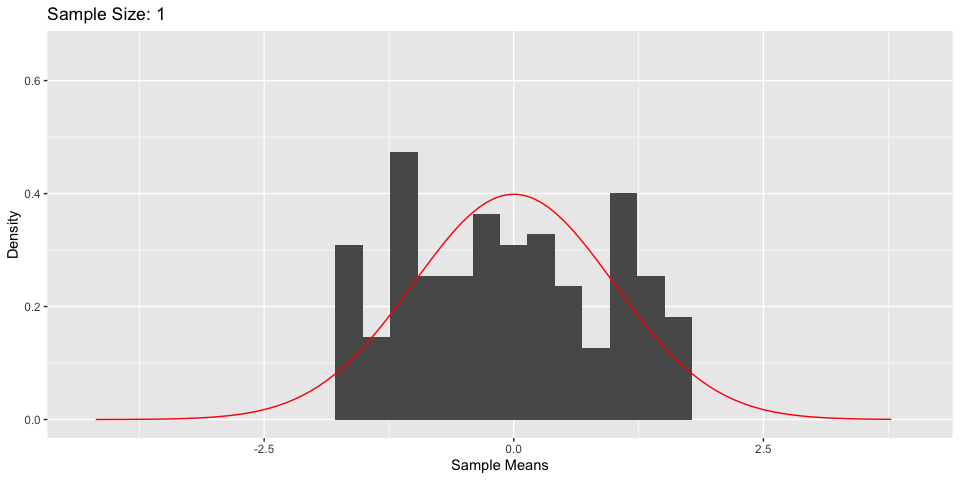Section 4: Statistical Relationships
Columbia University
2/21/23
Today’s Section
Correlation Coefficients
Law of Large Numbers
The Central Limit Theorem
Hypothesis Testing
Correlation Coefficients
- Statistically summarize relationships between numeric variables
- Range from -1 to 1
- Values closer to -1 or 1 indicate stronger relationships
Correlation Coefficients
\(Cor(X, Y) = \frac{Cov(X,Y)}{\sqrt{Var(X)*Var(Y)}} = \frac{\frac{1}{n-1}\sum_{i=1}^n(X-\bar{X})(Y-\bar{Y})}{\sqrt{\frac{1}{n-1}\sum_{i=1}^n(X-\bar{X})^2 *\frac{1}{n-1} \sum_{i=1}^n(Y-\bar{Y})^2}}\)
Equivalently:
\(Cor(X,Y) = \frac{\sum_{i=1}^n (X-\bar{X})*(Y-\bar{Y})}{ \sqrt{\sum_{i=1}^n(X-\bar{X})^2 *\sum_{i=1}^n(Y-\bar{Y})^2}}\)
Correlation Coefficients in R
- By hand:
Custom Functions in R
Custom Functions in R
Custom Functions in R
Law of Large Numbers
As \(n \to \infty\), sample mean approaches true population mean:

Central Limit Theorem
- As \(n \to \infty\), \(\sqrt{n}(\bar{X}_n-\mu) \to N(0, \sigma^2)\)
Central Limit Theorem
- What’s more, As \(n \to \infty\), \(\frac{\bar{X}_n - \mu}{\sigma/\sqrt{n}} \to N(0, 1)\)

Hypothesis Testing
- Null Hypothesis:
- Usually that true population mean equal to some value (\(\mu = x\))
- e.g., the true approval rate of Joe Biden is 50%
- e.g., the difference between the conservatism of Democrats and Republicans is 0
- Alternative Hypothesis:
- Two-sided: \(\mu \neq x\)
- One-sided: \(\mu > x\) or \(\mu < x\)
Hypothesis Testing
- Calculate the Z-Score based on null hypothesis:
- \(Z = \frac{\bar{X} - \mu_{0}}{\sigma/\sqrt{n}}\)
- Two-Sample/Difference-in-Means Test:
- \(Z = \frac{(\bar{X} - \bar{Y}) - (\mu_{0x}-\mu_{0y})}{\sqrt{\sigma_x^2/n_x + \sigma_y^2/n_y}}\)
Hypothesis Testing
- Under the Central Limit Theorem, the Z-Score should be
- distributed approximately standard normal
- if we repeated the sampling process many times with a large enough sample
- and if the null hypothesis is true
- distributed approximately standard normal
Hypothesis Testing
- Standard Normal Distribution has known properties
- Calculate probability of observing Z-Score at least as large as observed Z-Score
- if the null hypothesis is true
- This is the p-value
- Calculate probability of observing Z-Score at least as large as observed Z-Score
Hypothesis Testing: Example
nominate <- read_csv("~/Downloads/HSall_members.csv") %>%
filter(congress==118&party_code%in%c(100, 200)&
chamber!="President")
dem <- nominate %>% filter(party_code==100) %>% drop_na(nominate_dim1)
rep <- nominate%>% filter(party_code==200) %>% drop_na(nominate_dim1)
diff_in_means <- mean(rep$nominate_dim1) - mean(dem$nominate_dim1)
denominator <- sqrt((var(rep$nominate_dim1, na.rm = T)/nrow(rep)) +
(var(dem$nominate_dim1)/nrow(dem)))
z_score <- diff_in_means/denominator
round(z_score, 3)[1] 73.525Hypothesis Testing: Example

Hypothesis Testing: Example

Hypothesis Testing: Example
- One-Sided Hypothesis Test: \(\mu_{0R} - \mu_{0D} >0\)
- Two-Sided Hypothesis Test: \(\mu_{0R}- \mu_{0D} \neq 0\)
Hypothesis Testing: T-Distribution
Often use the t distribution instead of normal distribution
- especially with small sample sizes
t-distribution places more probability in the tails
In large samples, the t-distribution is equivalent to the normal distribution
T Distribution

Hypothesis Testing
- In R, can use the
t.test()function
Welch Two Sample t-test
data: rep$nominate_dim1 and dem$nominate_dim1
t = 73.525, df = 500.98, p-value < 2.2e-16
alternative hypothesis: true difference in means is not equal to 0
95 percent confidence interval:
0.8825648 0.9310273
sample estimates:
mean of x mean of y
0.5222045 -0.3845916 Confidence Intervals
We often want some idea of uncertainty in our estimates
Use Central Limit Theorem to construct “confidence intervals” around our estimates
Lower End: sample estimate - \(qnorm(0.975)*\)Standard Error
Upper End: sample estimate + \(qnorm(0.975)*\)Standard Error
Confidence Intervals: Example
Confidence Intervals: Example

Confidence Intervals: Example

Confidence Intervals
- Most common: 95% “Confidence Intervals”
- Does NOT mean we are 95% confident that the true population value is in the interval
- Real meaning: if we repeat the sampling process 100 times, 95% of the 95% confidence intervals will contain the true population value (on average)
Confidence Intervals

Confidence Intervals

Recap
Central Limit Theorem (and Law of Large Numbers) central to many scientific tasks
Used for calculating p-values, hypothesis testing, and constructing confidence intervals
p-value: probability of observing a Z-score/t-statistic at least as large as the one actually observed if the null hypothesis is true
Recap
- Confidence Intervals:
- lower bound: sample estimate - \(qnorm(0.975)*\)Standard Error
- upper bound: sample estimate + \(qnorm(0.975)*\)Standard Error
- We are NOT 95% confident that the true population value is in the interval
- Only that, if we repeated the sampling process many times, roughly 95% of the intervals would contain the true population mean
Statistical Relationships